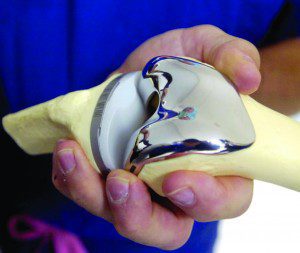By John C. Kagan, M.D.


In fact, the number of total knee replacement surgeries more than tripled between 1993 and 2009, while the number of total hip replacements doubled during that same time period. According to a study in the June Journal of Bone and Joint Surgery, obese and overweight patients, including young patients, accounted for the higher demand in knee replacements.
Other studies also have found a strong link between osteoarthritis (OA) in the knee and a high body mass index (BMI). The study found that patients ages 18 to 64 experienced a more rapid rise in overweight and obesity, compared to patients over age 65.
According to the Arthritis Foundation, the most common signs and symptoms of osteoarthritis are:
• Joint soreness after periods of overuse or inactivity.
• Stiffness after periods of rest that goes away quickly when activity resumes.
• Morning stiffness, which usually lasts no more than 30 minutes.
• Pain caused by the weakening of muscles surrounding the joint due to inactivity.
• Joint pain is usually less in the morning and worse in the evening after a day’s activity.
• Deterioration of coordination, posture and walking due to pain and stiffness.
While obesity is a major risk factor for knee OA, the good news is that patients who lose weight can significantly reduce knee pain. For some patients, weight loss and physical therapy may be prescribed. For others, knee replacement surgery may be the best option.
Fortunately, options for knee replacement surgery have improved and the benefits include a shorter hospital stay, less blood loss and potentially less scarring. Dr. Kagan’s practice, Athletic Orthopedic and Reconstructive Center, is pleased to be among the first practices in Southwest Florida to offer minimally invasive knee replacement including the quad sparing technique in which surgeons make smaller incisions without cutting the quad muscle. For many patients, this procedure decreases the length of their hospital stay, rehabilitation time and pain. As a result, most patients get back to normal activities more quickly.
Dr. John Kagan has more than 30 years of experience as an orthopedic surgeon treating patients in Southwest Florida. He specializes in treating patients with knee, shoulder and hip pain, as well as general orthopedics and hand surgery. For more information go to www.kaganortho.com or call 239-936-6778.
 Southwest Florida's Health and Wellness Magazine Health and Wellness Articles
Southwest Florida's Health and Wellness Magazine Health and Wellness Articles

